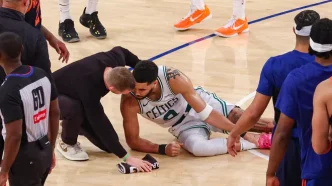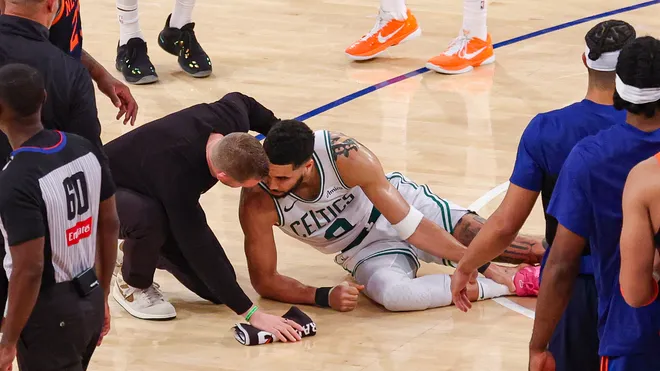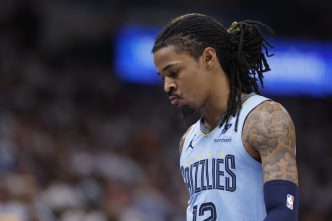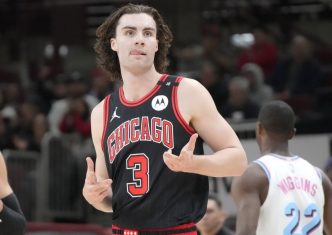On Tuesday, the Boston Celtics received the confirmation that fans and analysts alike dreaded: Jayson Tatum has ruptured his right Achilles tendon. This devastating injury occurred late in the fourth quarter of Monday’s loss to the New York Knicks, and it means Tatum will be sidelined for the remainder of the postseason, casting serious doubt on his availability for the entire 2025-26 NBA season.
As the Celtics’ leading scorer and a pivotal figure in their championship aspirations, Tatum’s absence alters the trajectory of the franchise dramatically. This isn’t just another player injury; it’s one of the most significant setbacks in NBA history, particularly given the timing and the stakes involved.
Looking ahead, the Celtics’ quest to overcome a 3-1 deficit—now facing a Knicks squad that has taken the upper hand in the series—has become exponentially more complex. The team’s strategy moving forward must account for the void left by Tatum, as well as the broader implications for the upcoming seasons.
Tatum’s Return: A Long Road Ahead
Historically, the recovery timeline for NBA players coming back from an Achilles rupture is lengthy. The fastest anyone has made a return in recent history was Jose Juan Barea in 2019, who came back in a little over 10 months. Given that history, it’s wise for the Celtics to plan as if Tatum will miss the entire regular season to follow. Postseason returns, while theoretically possible, remain exceedingly rare—Larry Krystkowiak’s brief comeback with the Milwaukee Bucks in 1991 serves as a stark reminder of how treacherous these injuries can be.
In more recent memory, the high-profile returns of Kevin Durant and Klay Thompson after similar injuries showed that while it’s possible to regain previous form, the road is fraught with uncertainty. Most teams would be cautious, as both players had long recuperation periods before they were fully cleared to play. Meanwhile, the Celtics would be wise to take an approach that succumbs to this reality—2025-26 may be a year without Tatum, even if there’s a glimmer of hope for a playoff return.
The Celtics’ Financial Tightrope
Adding to the challenges is Boston’s precarious financial situation. With Tatum’s supermax extension set to activate next summer, the team is looking at a considerable luxury tax bill—over $40 million above the threshold. Considerations of age and talent depth are paramount, particularly in light of Al Horford’s impending free agency at age 39.
The pressure is mounting for the front office. With questions hanging over their ability to build a championship-caliber team, Tatum’s injury hastens the need for difficult decisions. Managing a roster with multiple max contracts becomes untenable when the championship window suddenly shifts, possibly lengthening to 2027—when key players like Jrue Holiday are likely aging out of their prime.
Tatum’s injury could preclude any deals concerning Brown, who forms a high-salary duo with Tatum that consumes over 60% of the salary cap through the 2028-29 season. If the Celtics hope to maintain depth and competitiveness, adjustments will be necessary to balance the books without sacrificing future growth.
Expectations for Tatum’s Comeback
Tatum’s recovery will inevitably draw comparisons to Durant’s remarkable return after his Achilles injury at age 30. While there’s real hope for a strong return, there’s also the reality that an injury of this nature could impact Tatum’s durability moving forward. This season already saw him stringing together career-highs in missed games, and it’s reasonable to expect some caution regarding back-to-back appearances and minute limits in the early days of his return.
In terms of impact, skilled wings have historically returned well from Achilles injuries, but there are risks too—think of the careers that have not rebounded as successfully, such as DeMarcus Cousins and John Wall. All things considered, while Tatum is expected to regain a high-performance level, the path remains fraught with uncertainty.
Who Steps Up for the Celtics?
Faced with the reality of their star player’s departure, the Celtics now grapple with how to respond. After witnessing Tatum leave the game in a wheelchair, the emotional toll and shock are palpable. The team will have to rally quickly to maintain competitiveness in the series—a feat made more daunting by the dire state of a 3-1 deficit.
The Celtics will lean heavily on their defensive strengths, a spark that previously held the Knicks to under 200 points in the second and third games combined. Stopping Jalen Brunson’s penetration is critical; he scored efficiently in the paint, which is an area the Celtics can’t afford to overlook.
To counterbalance Tatum’s absence, Boston may consider putting more size on the floor, altering their offensive strategy to protect the rim, even at the cost of their shooting ability. With enough defensive grit and a team-focused mindset, the Celtics can summon the resilience to win three straight and potentially pull off one of the most storied comebacks in recent history.
However, the combined loss of Tatum and the missed opportunity in Game 4 has shifted the Celtics’ odds dramatically. What was once a bright path to the Eastern Conference is now a treacherous climb, and the Celtics will need every ounce of heart and effort to rise to the challenge.








